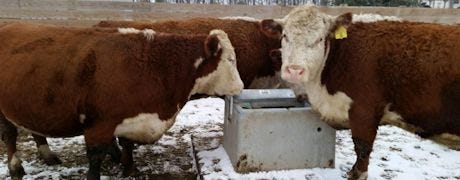February 2, 2015

This winter may have started out mild, but sub-zero temperatures have now arrived in Iowa and surrounding states, and will be hanging around for a while. Though most farmers have plenty of shelter to provide for their cattle to ride out the polar vortex, cattle still need a hand to help them weather this extreme cold. University Extension and Outreach and other local experts offer the following tips to help your herd warm up to a healthy spring.

COLD HARD CATTLE FACTS: The cold hard fact of the matter is with the majority of producers entering the calving season during critical temperature shifts, steps to keep animals protected from cold, wind and moisture can become the pivotal element in profitability.
Water should be your first concern in cold weather—Although cattle may not drink as much in colder temperatures, water is still vital. Keep natural water sources open and accessible during winter months, and make sure that waterers are well-maintained.
"We frequently make recommendations to our clients to keep a spare heating element and thermostat on hand," says Aaron Johnson, Bohlmann Quality Products' director of sales and operations. "Regular cleaning and maintenance of cattle watering equipment is also critical. Producers need to keep the heating elements free of mineral build-up and feed debris. Ensuring water is available for the cattle could be as simple as cleaning off the foreign material with a wire brush."
Make sure your cattle can get relief from high winds—They will take shelter in hills, trees, brush or fenced areas. A temporary shelter in the field, however, is ideal.
Give cattle enough feed—Though many producers realize the need for increased feed to offset the energy required to maintain core body temperature, most are unaware that the need is directly correlated to the cow's body condition. The website FarmOn.com recommends adding 1% more feed for every degree below 20 degrees Fahrenheit for cows in good condition with a healthy winter coat. For those that are thin and/or have a thinner coat, the additional feed needed is closer to two percent for every degree below 30 degrees Fahrenheit.
Feeding cattle at night helps in cold weather—Another recommendation is to feed cattle at night. The energy needed to digest food produces heat, and this helps the cow through the colder, nighttime temperatures.
Moisture in cold temperatures must be addressed—"Bedding may not always be necessary for the wintering cow herds, but in cases where cattle are wet, bedding is a must," says Carl Dahlen, North Dakota State University Extension beef cattle specialist. "The purpose of bedding is to help keep cattle dry."
The cold hard fact of the matter is that with the majority of producers entering the calving season during critical temperature shifts, steps to keep animals protected from cold, wind and moisture can become the pivotal element in profitability.
If you have questions about how to protect your herd from the elements and manage their feed needs, contact your local university Extension office. If you have questions on how to manage the water supply for your herd, contact the staff at Bohlmann Quality Products by phone at 800.325.2380 or log on to the Bohlmann Livestock website.
You May Also Like




